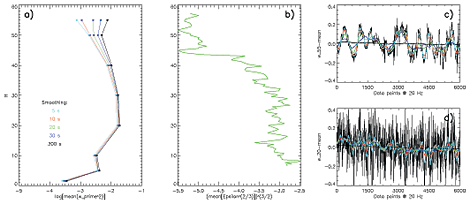Standard Turbulence Measurements:
Common Problems
A standard way of extracting turbulence information from temperature and velocity time series is to perform a Reynold’s averaging. This technique extracts the component of the ‘turbulence-induced fluctuations’ by substracting a smoothed version of the original time series from the raw signal:
u’(t) = UT(t) - U0(t)
The turbulent fluctuations (e.g., u’, w’, T’, …) are then used to calculate fluxes
(  , ,  ) and turbulent quantities such as the turbulent kinetic energy (TKE): ) and turbulent quantities such as the turbulent kinetic energy (TKE):

This technique introduces errors and uncertainties since, contrary to what is generally assumed, real data do not usually have this ideal well-defined spectral gap that separates the fluctuations generated by mesoscale processes from turbulence-induced fluctuations. For example propagating gravity waves typically have time scales of a few minutes period which, because of its proximity to the time scales of turbulence induced fluctuations, adds to the difficulty of separating true turbulence from non turbulent fluctuations.
The choice of the width of the smoothing window is a critical parameter that is very hard to determine. An averaging time of 5 min is typically believed to be optimal but it is far from being suitable to the majority of data.

Click on image for larger version.
The figure above shows that aside from the poor vertical resolution typically provided by instrumented towers, changes of the width of the averaging window has significant impact on the shape of the profile. More particularly, a typical 5 min averaging window would not capture the dramatic drop of turbulence intensity detected by the TLS around 40-50 m AGL and which marks the top of the nocturnal boundary layer. It was recently brought to our attention that not detecting such dramatic drops of turbulence over such small vertical extents would more certainly lead to large errors in the estimates of the structural load that wind turbines have to overcome. |



